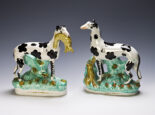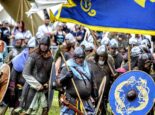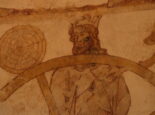Pboro Celebrates: astronomer George Alcock

The late, great amateur astronomer George Alcock was a dab hand at discovering comets and novae. How did he do it? By memorising the positions of up to 30,000 stars! Dr Richard McKim tell us more about Peterborough’s Astronomer
What George achieved was pretty impressive, considering he also had a day job.
That’s perhaps the most impressive thing; he was a very busy man and worked as a schoolteacher at Fletton. The other incredible thing was that he hardly ever used any specialist equipment. He mostly stargazed using the naked eye, sometimes with binoculars and occasionally a telescope.
He discovered quite a few novae [new stars] and comets. How did he do it?
He would have remembered the patterns of stars, about 30,000 of them! He didn’t know all their names of course, but it’s a bit like going into a room and noticing that something has been removed or added. He had a photographic memory for stars and he used his in-depth knowledge to pick out any changes. George made his first discoveries in the late 1950s and was the first to discover a comet from Britain since 1894, which gives you an idea of his commitment.
George was a local chap, so the fact you’re coming to Peterborough to give a talk on his life is very special.
In fact, I knew George for many years. When I worked at Oundle School we invited George to give a talk, which is where I first met him. We had a lot in common, so we corresponded and met up from time to time. I had great respect for George. He had an enormously demanding day job but then he would spend the night in a deckchair in the garden, watching meteors or looking for new things in the heavens.
You’re an amateur astronomer yourself. Is it fair to say he’s a role model for astronomers like you?
Yes. He started off watching meteors then progressed to comets and looking for new stars. He is a role model because he made so many discoveries in fields which are very difficult. Hardly anyone has ever discovered a comet from Great Britain – and he was able to do it. In fact, the last comet he discovered, in 1983, was named IRAS-Araki-Alcock because three people announced its discovery at the same time. The first was an automatic satellite called IRAS. Araki was a Japanese amateur and, of course, Alcock is George. At the time he would have been over 70 and was making these observations with binoculars through the double-glazing of his house!
It shows how pure determination can sometimes match the best equipment.
Absolutely, because most professionals are looking at only a tiny area of the sky, whereas George was observing the whole sky, so he saw things that other people missed.
He also was a very keen observer of nature: wildlife, flowering times, different birds and so on. He would record all of this and illustrate it on a sheet, which he’d then duplicate and send out to his old pupils every week. There were hundreds and hundreds of these, some of which I’ll show in the talk. George also did watercolours, pencil sketches of churches – all sorts of things like that. But any kind of natural phenomena, he was the observer of it.
Peterborough’s Astronomer
Tues 23 Oct, 7.30-9pm
Peterborough Cathedral Visitor Centre
Tickets: £5
To book: 01733 355315, www.peterborough-cathedral.org.uk/events
George Alcock was a prolific Peterborough-based amateur astronomer, commemorated by a memorial tablet in Peterborough Cathedral. Join Dr Richard McKim – a member of the British Astronomical Association – for an illustrated talk about Alcock’s life and work.















